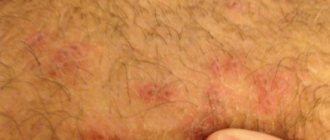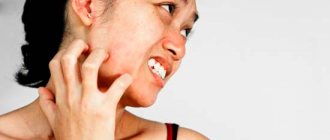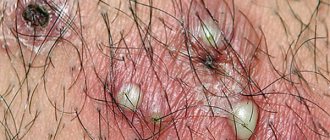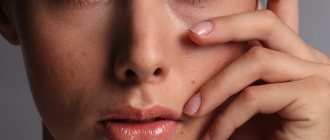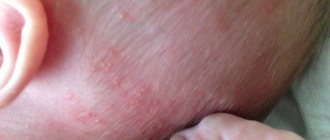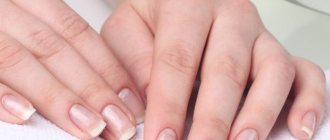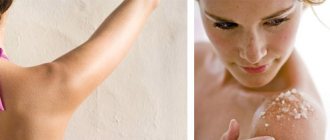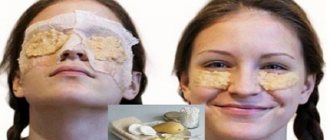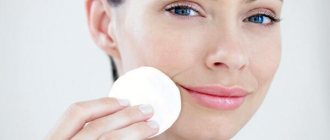What is milium or millet
milia (millet) in the photo
Having seen a white pimple on the face, every second person tries to get rid of it as quickly as possible, but without knowing the differences between millet, acne and other dermatological manifestations of malfunction of the sebaceous glands, you can cause serious damage to the condition of the skin, leave scars and that the worst thing is to get an infection. Let's look at what white pimples on the eyelids and face are, how to distinguish milia from a photograph from a regular pimple on the eyelid, how you can get rid of them, as well as possible measures to prevent their appearance.
In appearance, these are small white seals, white or ivory, with a diameter of no more than 3-4 mm. Millet most often appears on the face: these are small groups of white pimples on the forehead, chin, nose and eyelids. Separately, nodules can be localized directly on the eyelid, on the earlobe and on other areas of delicate skin.
Milium is a cystic neoplasm in the tissues of the epidermis, which appears in the crater of the follicle, externally resembling a grain of millet, only of a porcelain hue. Most often they appear in the face area, in areas with thin and delicate skin. In rare cases, milia can appear in certain areas of the body: in the armpit, under or on the breasts, in the groin area, and in the popliteal fossa. They appear without any previous signs, and then disappear on their own. These formations do not cause symptomatic discomfort: they do not itch, flake or become inflamed if you do not touch them or try to squeeze them out. And around them is concentrated completely healthy skin.
In addition, milia can appear in infants several days or weeks after birth. According to statistical data from dermatologists, millet grass occurs in women several times more often than in representatives of the stronger half of humanity. Although, according to doctors, this trend is no longer associated with the genetic predisposition of the female gender with this kind of pathology, but with the fact that girls, caring about their appearance, more often turn to a dermatologist with this problem.
The glands that produce sebum, located in the upper layers of the dermis, the channels of these glands, usually connect to the mouths of the hair follicles (all the skin on the face is covered with a layer of invisible vellus hair). The sebaceous glands secrete sebum to ensure normal skin hydration. This fat is called sebum, and includes, in addition to the fatty secretion itself (a mixture of lipids and compounds of triglycerides and cholesterol), dead cells, keratin and squalene. When secreted through the ducts and follicles, sebum covers the skin with a specific protective film that protects the skin from harmful bacteria, drying out, exposure to UV rays, dust and other things.
At the same time, through the ducts connecting the sebaceous glands with the mouths of the vellus follicles, old dead skin flakes are constantly removed. Milium is an impenetrably closed follicle or outlet of the sebaceous gland due to the accumulation of horny masses and fatty deposits.
Milia in infants
White pimples up to three millimeters in diameter on the face of infants often turn out to be “pimples.” Such pimples are not difficult to recognize and can be seen in the photo.
Milia in a child can appear not only on the eyelids, but also on the nose, scalp, arms, legs or torso. In addition, in infants, as in adults, white pimples sometimes appear inside the mouth (on the hard palate and on the inner surface of the lips).
Experts say that milia are an absolutely natural phenomenon for infants. Such pimples in a newborn do not require treatment and quickly go away on their own in adulthood. They are completely harmless and are not associated with infections or diseases.
Preventing the appearance of millet
If you are prone to the formation of blemishes (as well as comedones), you should take into account two factors that you yourself can influence: lifestyle and skin care.
Proper skin care
Inadequately selected means can aggravate the situation and cause prosyanka. In particular, milia on the eyelids can appear as a result of the use of face creams in the periorbital area. It is useful to read articles on our website dedicated to caring for the skin around the eyes.
Caring for the skin around the eyes
When choosing care for skin prone to milia, pay attention to:
- skin cleansing products with exfoliating and sebum-regulating effects;
- peelings for home use (factory-made, not homemade!);
- light non-comedogenic creams.
Do not cleanse or degrease the skin too intensively, so as not to provoke its protective reaction in the form of hypersebony. The consequence may be the formation of milia.
You can't get rid of millet with the help of cosmetics, but we have made a selection of products that will provide competent care for skin prone to the formation of milia.
Cleansing and toning
Normaderm Phytosolution, Vichy cleansing gel with salicylic acid, a probiotic derivative and microelements eliminates impurities and excess sebum from the skin, and reduces the appearance of pores.
Garnier Clear Skin Anti-Blackhead Cleansing Gel for oily skin contains salicylic acid and zinc to target imperfections.
Pore tightening lotion Effaclar, La Roche-Posay with acids gradually and gently exfoliates dead cells, cleansing pores and reducing their size.
Blemish & Age Solution, SkinCeuticals' tri-acid cleansing toner helps gradually exfoliate dead cells for renewed skin.
Scrubs and peelings
Mineral peeling mask “Double Radiance”, Vichy - AHA acids and abrasive particles exfoliate dead cells, removing them from the skin.
Nightly Refining Micro-Peel Concentrate, Kiehl's, with a combination of several acids, works gradually and without aggression, helping to accelerate the natural process of skin cell renewal.
Care
Normaderm Phytosolution, Vichy double-action corrective care combines renewing properties with moisturizing and strengthening the skin's protective barrier.
Highly effective night cream Retinol 1.0, SkinCeuticals provides a pronounced anti-aging effect, reduces enlarged pores, contains pure encapsulated retinol (1%)
This ingredient promotes exfoliation, which is very important for oily skin prone to hyperkeratosis.
Corrective cream-gel for problem skin against imperfections and signs of post-acne Effaclar Duo (+), La Roche-Posay exfoliates, including through a combination of lipohydroxy acid (LHA) and salicylic acid, and also moisturizes the skin for 24 hours.
Proper nutrition
Proper nutrition for oily skin is considered to be a diet that excludes high-carbohydrate foods: sugar, wheat, white rice and products made from them. The basis of the menu should be green vegetables, natural fats (both animal and vegetable, not refined), and proteins.
Eating sugar can cause millet weeds.
Varieties
A pimple under the eye is a collective concept that does not make it possible to make a diagnosis. These formations are distinguished by shape, size, color, and features of manifestation. The location matters - whether the pimple has formed above the eye, under it, between the eyebrows or on the eyelid itself. Acne in women is different from that in men.
Reds
A red pimple on the eye most often has an inflammatory origin. Redness appears due to blood flow to the site of infection. A pimple on the eyelid may have a white top - this is accumulated pus. After a few days, it breaks out and instead of a pimple, an ulcer forms.
White
Small white pimples that appear near the eyes are called milia, or pimples. They are formed in places of greatest accumulation of sebaceous glands and are associated with their excessive functioning. Milia do not cause pain or itch. A person is only concerned about aesthetic discomfort.
Small
A scattering of small pimples is characteristic of disruption of the sebaceous and sweat glands. They are not accompanied by itching or pain. They are flesh-colored or white. Small pimples on the upper eyelid are a manifestation of an allergic reaction. It occurs in response to the use of cream or decorative cosmetics. Accompanied by itching.
Large
A large pimple on the lower eyelid is a sign of dacryocystitis, or blockage of the tear ducts. The disease develops due to insufficient hygiene. Also, dacryocystitis in infants due to incomplete development of the lacrimal glands. The disease is characterized by moderate pain in the eyelid area and difficulty blinking.
Barley
This is an inflammation of the sebaceous gland, usually occurring on the upper eyelid above or below the eyelashes. First, a swelling appears, which quickly becomes inflammatory in nature. There is redness and swelling of the eyelid, and a white purulent dot appears at the top of the red pimple. When pressing on it, pain occurs.
Barley springs up due to infection of the sebaceous gland. The disease is provoked by insufficient hygiene and hypothermia.
Chalazion
A pimple on the eye that appears on the lower or upper eyelid is called a chalazion. It is a small white lump. It is not accompanied by pain, but prevents a person from blinking. Very rarely it forms inside the cartilage of the eyelid, then the person is bothered by constant discomfort.
Xanthelasma
A yellow pimple near the eye is an accumulation of cholesterol, or xanthelasma. With increased cholesterol levels in the blood, it begins to be deposited in the skin. First of all, deposits become noticeable in the eyelid area, since the skin there is thinnest.
Xanthelasmas also indicate liver disease, in which cholesterol metabolism is disrupted. The deposits are often small in size (up to 5 mm), but can coalesce and reach several centimeters in diameter. They are dense, painless, and usually do not cause discomfort. Large xanthelasmas make blinking difficult.
Lipoma
Large white pimples on the eyelids are fatty deposits, or lipomas. They are formed due to the accumulation of fat under the skin. Lipomas protrude above the surface of the eyelid and can reach several centimeters in diameter. They do not cause pain, but large fatty deposits make it much more difficult to open the eyes.
Bubble
Watery blisters along the edge of the eyelid and in the corners of the eyes are formed due to blockage of the meibomian gland. The disease is typical for older people and patients who use contact lenses. Less commonly, the gland becomes clogged due to insufficient hygiene or the use of too much cosmetics.
Rash
Excessive pimples around the eyes are called rashes. It can have different origins.
- Allergic. Appears upon contact with an irritating substance or consumption of food. It looks like a scattering of small red pimples, accompanied by itching.
- Herpetic. Caused by the herpes virus. Small bubbles containing liquid appear. They quickly burst, forming erosion.
- Acne. Occurs due to increased oily skin. Small white pimples with an inflammatory rim appear on the eyelids and around the eyes.
Pimples on the eyelids can appear in a small child due to frequent skin contamination.
How to treat “millet”?
Small white pimples that appear on the upper or lower eyelid should not be removed by squeezing yourself. Firstly, you won’t succeed, since the “millet grains” are very small and dense.
Secondly, you can get an infection that will turn a small white formation into a huge purulent one. Agree, you don’t need such an effect.
And so, let's get acquainted with the main methods of treating “millet”. The following medications are used for treatment:
- benzoyl peroxide, which has excellent anti-inflammatory effects;
- salicylic ointment, which has drying and antibacterial effects.
Review of home methods for treating and removing grass under the eyes
Before using any methods or medications for milia, you should consult a cosmetologist or dermatologist so that the doctor can confirm the diagnosis.
It is forbidden to squeeze out dots near the eyes. This leads to injury to the follicle and sebaceous gland, the formation of a large infected acne or boil, which will leave a noticeable scar.
Millet rarely disappears on its own. Different types of products are used to treat milia.
Cosmetology
You can get rid of dark spots under the eyes at home using cosmetic methods. The choice of method for removing rashes depends on the location, number, size and depth of milia.
Single formations can be removed mechanically. The skin around the eyes is cleaned, treated with an antiseptic, the point is opened with a needle and its contents are curetted. Small post-procedure wounds quickly heal on their own.
For multiple whiteheads, removal is indicated. A popular method is a laser; in dermatology, carbon dioxide is usually used; it removes pathological tissue in layers as accurately as possible. Healthy skin around the eyes is not injured mechanically or thermally. The operation is without blood loss, performed non-contact, sterile, and has a good cosmetic effect. Anesthesia is required - application or infiltration.
Another way to treat milia around the eyes is electrocoagulation. Electric current destroys the defect, cauterizing the vessel and preventing bleeding.
Contraindications:
- arrhythmia;
- high blood pressure;
- angina pectoris;
- increased body temperature;
- pacemaker.
The radio wave method is atraumatic coagulation and excision of acne in the eye area. Radiofrequency waves are applied to the point, the milia cells evaporate. Tissues removed by this method are suitable for histological examination.
Medication
You can remove milia using retinol-based creams and pharmaceutical ointments.
Vishnevsky ointment is applied pointwise with a cotton swab under the patch, preferably at night. There is a possibility that after several procedures the millet will open and its contents will come out. Sometimes the process is accelerated by opening the formation with a sterilized needle, but this is dangerous: if located near the eye, the organ of vision can be damaged.
If an inflammatory process occurs, apply ichthyol compresses. After removal, it is useful to make masks from bodyaga. It helps heal wounds and relieve inflammation.
Benzene peroxide, which inhibits the exfoliation process, should be used carefully. It is applied pointwise to the milium. A white spot may appear on the skin.
Retinol, as a fat solvent, is used to treat each formation near the eyes in a targeted manner. It minimizes hyperkeratosis, reduces sebum production, dissolves the substance that makes up milia, and cleanses pores.
If an infection occurs during removal, according to the doctor's indications, use ointment with Erythromycin.
Folk
In the fight against milia in the eye area and for their prevention, homemade folk scrubs and masks are suitable.
Milk-gelatin film mask:
- Mix a tablespoon of gelatin and milk.
- Microwave until gelatin dissolves, 10-15 seconds.
- Apply with a brush to the area with milia near the eyes.
- Wait until dry, remove.
- Repeat.
- Wipe your eyelids with lotion.
You can apply a mask of ripe tomatoes. Grind a juicy soft tomato into puree, add a spoonful of oatmeal crushed in a blender. Keep on eyelids for 8 minutes. Do it once a week.
Homemade scrubs for whiteheads near the eyes usually contain oatmeal. The flakes need to be ground: finely, but not into dust, add honey to soften. Apply with smooth movements along massage lines onto damp skin with milia for two minutes. Rinse off with warm water.
Soda peeling:
- Lather baby soap or shaving cream.
- Apply to face.
- Place baking soda on a cotton swab.
- Massage your face for three minutes.
- Rinse off with cool water.
- Apply a light moisturizer.
You can make lotions from sea salt, apply applications of blue, white clay, sour berries - viburnum, cranberries - to the milia in the eye area.
https://youtube.com/watch?v=u_m4PBt3ND4
Causes
Why do milia appear under the eyes? The causes of such acne are still not clear. According to experts, completely different factors can trigger the formation of milia. These include the following.
Heredity. Of course, such a factor cannot be called the main and only reason for the formation of whiteheads. But if parents have them, then the likelihood of the same rashes appearing in children is quite high.
The appearance of milia can be caused by improperly chosen or insufficient skin care, including if it is prone to oily skin. As you know, such covers have enlarged pores, which are prone to clogging with the contents of the sebaceous glands. By the way, not only milia form on oily skin, but also rosacea, cystic acne, pustular acne and other acne diseases.
Under the eyes, milia, photos of which are presented in this article, can also appear due to hormonal imbalance. That is why pregnant women, teenagers and people over the age of 47 most often suffer from whiteheads, when the level of sex hormones in the body significantly decreases.
An unbalanced diet can also lead to the appearance of white pimples. If a person’s diet is dominated by smoked foods, fatty foods and various sweets, then the likelihood of milia occurring increases significantly.
The main causes of milia on the face include diseases of the gastrointestinal tract, as well as malfunctions of the pancreas and thyroid gland.
Why does millet appear?
The mechanism of development of this process is not yet fully understood, as are the reasons for its occurrence. The probabilistic reasons causing the appearance of millet were:
- Genetic determination (this theory is confirmed by the fact that most people with milia had parents or close relatives with such formations).
- Hormonal imbalance. This reason explains that millet often appears during puberty, pregnancy or old age, when hormonal changes in the body occur.
- Eating disorder. Excess of sweet, fatty, fried foods increases the likelihood of such acne.
- Improper hygienic facial skin care. It has been noticed that people with oily skin, without proper care, develop significantly more milia.
- Hyperinsolation.
- Endocrinopathies.
Multiple milia on the upper and lower eyelids
The pathogenesis of the disease, according to some authors, is associated with a violation of the secretion of the sebaceous glands, blockage of their duct and the formation of a cavity filled with fat. According to others, it is based on an imbalance between the high rate of division and keratinization of epithelial cells and the low rate of their desquamation. As a result, excess dead skin cells form cysts filled with keratin.
Note: millet may appear in newborns. This is associated with imperfections in the digestive system and impaired absorption of various vitamins and minerals, as well as impaired regulation of the activity of the sebaceous and sweat glands. This condition goes away on its own and does not require additional intervention.
Millet in a newborn
Wen, millet or white dots at the site of the scar: causes of appearance, treatment
It happens that a person does not have such problems as long as after a burn, blow or operation there is a scar on which a wen appears over time. Such a wen, millet or milia is closely associated with a skin disease or possible inflammation, abrasion, burn and scar. This occurs only in those parts of the body where the skin has previously been damaged as a result of illness or injury. If dead skin cells get trapped under the top layer of skin during this injury, they can encapsulate there and leave a single wen.
That is, this is again an abundant work of the sebaceous glands. Such milia are considered secondary - they arise precisely in places of damage. Primary clearings form spontaneously and disappear just as unexpectedly. For example, on the skin of a baby as a result of contact with a new environment, or on an adult after contact with ultraviolet radiation.
Other possible reasons for the appearance of milia at the site of a scar after surgery are:
- due to strong skin tension
- or as a result of their incorrect connection/fusion
- tissue regeneration and individual predisposition
- possible inflammation, which is often accompanied by itching and pain
In this case, there is no need to panic; in most cases, it resolves on its own. But it wouldn't hurt to consult a dermatologist. If milia bothers you or causes discomfort, then you should visit a surgeon for timely removal. Most often, such a wen is removed mechanically.
They may also prescribe ointments for resorption of scars and these same milia:
- Contractubex
- Dermatix
- Heparin ointment
- Hydrocortisone
- Vishnevsky ointment
And even more so, it is forbidden to open them with a needle at home!
Types of milia
Milia on the eyelids can be divided into two main groups:
- Primary, appearing unexpectedly without good reason.
- Secondary. Appear due to injuries, skin damage or as a result of an inflammatory process.
The key feature is the fact that white dots on eyelashes and skin appear not in single units, but in groups at once. They only cause aesthetic discomfort, but need urgent removal.
Barley is an infectious and inflammatory formation. The lump has a fairly dense texture, usually appears on the eyelid, and is accompanied by swelling, redness around the eye and severe pain.
With timely treatment and strengthening the immune system, you will prevent the onset of purulent abscesses and chalazions. If there is a delay in seeking medical help, surgical removal is performed.
Xanthelasma is a small, flat, yellow pimple that occurs both on the eyelid and under the eyes. It can be single or multiple. It is more common in patients with a diseased liver, metabolic disorders, and high cholesterol.
A chalazion is a round, dense nodular formation. It occurs from the accumulation of secretions due to blockage of the sebaceous ducts around the eyes, as a result of ineffective treatment of barley, or due to infection. In addition, the neoplasm may be a cyst, which requires specific treatment.
Any neoplasm should be addressed by a doctor. The ophthalmologist, after conducting a diagnosis, will find out the cause of the abscess and prescribe the necessary medicine.
An ordinary pimple (milium) differs from a “stye” in color. If the first is pure white, the second is red or reddish. Later, a yellowish formation appears on the “barley,” which indicates the presence of pus inside it.
If you have determined that you have milia, then let's now find out why they appeared.
Xanthelasma is a small, flat, yellow pimple that occurs both on the eyelid and under the eyes. It can be single or multiple. It is more common in patients with a diseased liver, metabolic disorders, and high cholesterol.
How to remove milia on the face
If millet appears on the face, you should take antibiotics and use ointments for external use.
If the formations are on the eyelids, then cryotherapy is used before removal, since the skin on this area of the face is very thin and sensitive.
Any mechanical impact can lead to redness and inflammation of the skin.
Several different methods are used to remove hard white pimples: hardware cosmetology, mechanical removal and the use of folk methods at home.
Hardware treatment
Hardware removal of millet is performed by a cosmetologist
In order to choose the best therapy, the specialist should pay attention to the following factors:
- area of the affected skin area;
- presence or absence of contraindications;
- number of white pimples;
- patient's health condition.
Hard white bumps can be removed using hardware in two ways:
- Laser coagulation. White spots on the skin are burned. After exposure to laser radiation, a crust forms on the face, which falls off over time. After this procedure, the patient must treat the affected areas of the skin with disinfectants. The advantages of laser coagulation include painlessness, speed, and a positive effect immediately after the procedure. This milia removal method is suitable for everyone.
- Electrocoagulation. This method differs from the previous one only in that instead of laser exposure, high-frequency alternating current is applied. After this procedure, the skin remains clean and smooth.
Removing millet grass mechanically (by a doctor)
Removal occurs using a needle and curettage.
Curettage is an outdated method for removing millet grass. The white bumps are removed with a special device that may resemble a spoon. The procedure is quite painful and after it scars and wounds remain on the skin.
Mechanical removal of milia using a needle occurs in several stages:
- Disinfection of the skin.
- The white tubercles are pierced with a thin sterile needle.
- Through the resulting hole, the contents of the white tubercles are removed.
- Disinfection of the area of skin where the millet was present.
After this procedure, there are no traces left on the skin, since the hole through which the contents of the milium were removed is very small. It is not recommended to remove more than 10 white pimples in one session, so as not to injure the skin.
How to get rid of millet at home
You can get rid of white balls on your face using folk remedies:
- Viburnum berries. Ripe berries need to be crushed. Soak a cotton pad in the resulting juice and apply it to the affected areas of the skin. You can also make a mask from viburnum juice by adding a little flour to it. Apply the resulting mixture to your face and leave for 40-45 minutes.
- Soda scrub. You need to foam the soap and add one dessert spoon of soda. Apply the resulting mixture to the affected areas of the face with massage movements. After this procedure, redness of the skin may appear, which will disappear within two days.
- Oatmeal scrub. Grind a small amount of Hercules cereal in a coffee grinder, add a teaspoon of salt and soda to the resulting flour. Mix the mixture with a small amount of foam for washing and apply to the face with massage movements.
- Pumpkin. Grate the berry pulp on a fine grater, add a little sour cream to it. Apply the resulting mask to your face and leave on for 15 minutes.
- Chamomile and calendula. Pour one tablespoon of herbal flowers into 200 ml of boiling water and let it brew. Soak a cotton pad or bandage in the resulting infusion and apply compresses to the affected areas of the skin.
- Paraffin mask. Treat your face with a disinfectant. Melt 60 grams of paraffin and apply it with a brush to the face, avoiding the eye and lip area. After the first coat, apply the second. You can remove the mask after it has completely hardened.
Skin types
Taking into account the available fatty lubricant and moisture content, the skin is divided into several types:
- Normal. Has a clean and fresh look. No peeling is observed.
- Fatty. It is characterized by excessive shine due to increased sebum secretion and insufficient blood flow. Too much fat can clog pores. There is a predisposition to the appearance of acne. The pores will be enlarged and often closed with comedones. However, this type has a great advantage: it is quite insensitive.
- Dry. Characterized by different origins. In certain situations, when there is no appropriate care, peeling, tightness or irritation is noted. In addition, there is susceptibility to temperature changes.
- Combined. It occurs more often than others. It is characterized by uneven distribution of fatty lubricant. This type of dermis must be taken into account in the process of caring for it. In adulthood, mixed skin type becomes normal.
Treatment
Professional methods for removing millet grass
This procedure is usually offered by all beauty salons, so choosing a doctor is usually not difficult.
Important! Despite the fact that removing grasses is a fairly simple procedure, you must trust its implementation only to a cosmetologist. You should always ask the specialist if you have a diploma of relevant education.
You should always ask the specialist if you have a diploma of relevant education.
What methods are used to remove eyelid stains in salons?
- Laser. The doctor acts precisely on the problem area using a special high-frequency device - a laser. The patient does not experience pain, and the procedure itself takes no more than 10-15 minutes (depending on the number and size of the rash).
- Alternating current and needle. Used when large sized grasses need to be removed.
- Manual extrusion. The doctor punctures the pimple with a sterile needle and manually squeezes out the contents of the nodule. This method is the most accessible, but at the same time the most traumatic, since in rare cases small scars may occur.
After any of the above procedures, you must maintain absolute hygiene of the face and eyelids, and also refrain from using decorative cosmetics for at least 2-3 days.
How to get rid of milia at home?
If financial possibilities are limited during this period, you can get rid of millet grass at home. What is needed for this:
prepare a sterile syringe needle (it must be new); Thoroughly cleanse your facial skin of dust and impurities; Disinfect the skin of the eyelids and face with a weak solution of Chlorhexidine; prepare a liquid for steaming the skin (pour 2-3 liters of boiling water into a clean basin, add 0.5 cups of chamomile or calendula infusion, stir), tilt your head over the container and cover with a towel for 5-10 minutes; treat hands with alcohol; Gently pierce the millet with a needle and squeeze out the contents with clean hands (it is important that blood flows); treat the resulting wound with any antiseptic solution (you can also use Chlorhexidine); repeat for all milia, following the sequence of actions.
Manual squeezing will be effective for initial rashes, but sometimes it happens that the rashes return again after some time. In this case, you can make a special mask from bodyaga powder. It is prepared very simply:
- boil the glass container;
- pour bodyaga powder (about 50-100 g) into a bowl;
- add hydrogen peroxide (3%) so that the consistency is like a thick cream or paste;
- apply the composition to the eyelids (spotwise!) and leave for 10 minutes;
- Rinse off the product with warm fresh water.
Important! After the procedure, a tingling sensation may occur on the eyelids. This means that everything is done correctly, and the composition begins to act
Treatment with medications
Drug treatment is carried out under the guidance of a cosmetologist and strictly according to his recommendations.
- antibiotics
- retinoids
- Tretinoin
- a course of keratolytics - exfoliating drugs. The formations mature, open and heal without leaving a trace.
In addition to medications, salons carry out a number of procedures to effectively remove the rash:
- laser – removes grass for a long time
- electrocoagulation - the price is quite low, and the unwanted rash is effectively removed
- curettage – manual removal of whiteheads.
Retinoids are preparations containing structural analogues of vitamin A, which in its pure form is a rather unstable compound. There are many options for creams that are used to treat acne and wrinkles. The active compounds in creams are powerful antioxidants.
Tretinoin is a first-generation drug containing retinoids.
Not for use during pregnancy and lactation, as it affects the fetus and baby.
Not recommended for severe allergic reactions.
How to remove brown circles around the eyes. Brown circles under the eyes: causes and solutions
Brown circles around the eyes bring a feeling of dissatisfaction with appearance, and women develop an inferiority complex. The occurrence of this defect depends on 2 factors: hereditary or acquired. If the formation of such circles is due to physiological reasons, then they look like clearly defined bruises. To eliminate the problem, you must first find out the cause of its occurrence, since dark circles under the eyes can be one of the symptoms of a serious disease.
- 1. Causes of dark circles 1.1. Signs of diseases
- 1.2. Bad habits
Causes of dark circles
To make sure that dark circles under the eyes are caused by a genetic factor, you should pay attention to the skin around the eyes of your parents. But the appearance of brown circles may be a signal of a malfunction in the body or a sign of the onset of a serious illness.
Therefore, first of all, it is necessary to find out the nature of the external defect and choose the appropriate solution to the problem.
But the appearance of brown circles may be a signal of a malfunction in the body or a sign of the onset of a serious illness. Therefore, first of all, it is necessary to find out the nature of the external defect and choose for yourself a suitable solution to the problem.
The reasons why dark spots appear are varied:
- dark circles may appear as a result of lack of sleep,
- bags under the eyes indicate extreme stress, increased fatigue,
- with insufficient, unbalanced nutrition or being on a diet,
- with a lack of iron in the body,
- improper care of thin eyelid skin,
- dark circles under the eyes are a sign of a serious illness (metabolic disorders, liver disease, problems in the gastrointestinal tract).
To deal with stains, you need to correctly determine the nature of their occurrence, for this you need to consult a doctor and cosmetologist. Timely identification of the cause of the appearance of brown circles in women will allow timely initiation of treatment procedures.
Signs of diseases
If the problem of the formation of dark circles under the eyes is caused by the presence of a disease, then after the diagnosis is established, it is necessary to begin treatment procedures to eliminate the disease that has arisen as soon as possible. After recovery, the skin will return to normal.
Dark spots may indicate the following pathologies:
- cholecystitis,
- giardiasis,
- hypothyroidism,
- cholelithiasis,
- helminthiasis,
- anemia,
- diseases of the nervous system,
- cardiac, adrenal and renal failure.
Bad habits
The eyelids and area under the eyes are the most unprotected and fragile part of the face; their skin is very thin and has a small number of sebaceous glands. Therefore, stressful situations are negatively displayed on the face in the form of dark circles under the eyes.
Bad habits - smoking, drinking alcohol, being overweight - lead to impaired blood flow and increased pigmentation of the eyelids, which causes spots to appear.
How to get rid of stains
In order to get rid of dark spots around the eyes, the following conditions must be observed:
- walk in the fresh air more often, lead an active lifestyle,
- get a full night's sleep,
- get rid of bad habits,
- apply refreshing compresses to the skin of the eyelids and eye area,
- eat a balanced diet.
The latter means that you need to eat three times a day, and also include light snacks throughout the day. It is worth giving up junk food, replacing it with fresh vegetables and fruits, fish. The following categories of products are considered harmful:
- flour,
- fatty,
- spicy,
- salty,
- sweet.
How to eliminate a defect with cosmetics
To eliminate brown circles under the eyes, you should use specialized nourishing creams and whitening serums. The main thing is that the products contain components such as:
- collagen,
- elastin,
- proteins,
- special oils.
To remove spots under the eyes, you can use folk remedies for whitening the skin of the eyelids: herbal tinctures, whitening herbal masks, rubbing with ice cubes from chamomile decoction.
Until the problem is resolved, you can use concealer, corrector, or foundation to mask the spots.
When applying, you need to apply the product carefully, in an even thin layer, so as not to damage the thin skin around the eye area. In some cases, gentle chemical peeling, injections of hyaluronic acid into the eyelid area and other cosmetic procedures may be relevant.
The pimple is very swollen, what should I do? If you squeeze out a pimple and a tumor appears: how to remove it, what to do
Every person has had a pimple pop up on their body at least once in their life.
Often there is not enough time and energy to visit a doctor and properly treat acne, so people use home remedies or use old methods of mechanical acne removal. Contrary to existing prohibitions and warnings from cosmetologists, squeezing out pimples does not stop, since everyone wants to get rid of pimples as quickly as possible, especially if it is in a visible place.
If, after a person squeezes out a pimple, a tumor appears, a doctor’s consultation and long-term treatment may be necessary.
Why can a tumor or lump form after squeezing a pimple?
The formation of a tumor under the skin after the pimple squeezing procedure most often occurs for the following reasons, namely:
- Breakthrough of the abscess. Each inflammatory formation on the body has a subcutaneous capsule. The purulent contents of the pimple accumulate in it and as it matures, it comes out. During mechanical action on acne, the pustule may burst and the entire contents of the pimple will not come out to the surface of the skin, but will penetrate into the denser layers of epidermal tissue. If the immune system does not react with an aggressive reaction of rejecting foreign substances, then the biological fluid of the abscess hardens and forms a compaction on its own. Such a formation can periodically become inflamed and painful.
- Infection. In the absence of proper antiseptic treatment of the pimple while squeezing out its contents, an infection gets inside and starts the process of re-inflammation. Due to the prolonged pathological process in the subcutaneous layer of the epidermis, the abscess becomes denser and its natural removal from the skin becomes impossible. The affected area of the skin becomes bluish and may periodically become inflamed. An infectious lump requires surgical removal. It will not resolve on its own.
- Vascular factor. If the pimple pustule is located too close to the smallest capillary vessels, it can lead to the formation of tumor lumps. The reason is that when pressing on the surface of the pimple, the blood vessels are injured, they are destroyed and bruises appear. Subsequently, they form into dense clumps. Over time, such seals tend to dissolve on their own.
In order to avoid the appearance of tumors after mechanical removal of acne, you should refrain from performing these procedures. At least not to do them yourself at home, armed with improvised means. If such a need has already arisen to extract the purulent contents of the pimple onto the surface of the skin.
It is better to contact a dermatologist who, in the absence of medical contraindications, will sanitize the acne and perform professional cleaning of its pustule, which will eliminate the possibility of a secondary infection entering the skin and the development of other complications.
Photos before and after
See ways to squeeze out blackheads. About what to do with acne vulgaris on the face. Find out further.
How to get rid of acne on your face? The answer is here.
A pimple is not a decoration, but inflammation after squeezing it looks even more unsightly.
Therefore, if imperfections appear, you should immediately seek advice from a dermatologist, without trying to choose a skin treatment plan on your own.
What to do with the lump, how to remove it?
Removal of a lump formed after squeezing out a pimple can be carried out in a healthcare facility, where a surgeon will cut out the tumor, clean the epithelial sac in which the tumor was located, and apply cosmetic sutures. The scar after this type of surgery will be almost invisible.
If a lump has formed on the face and there is still a fear of surgical removal of the tumor so that there is no scar left, then the following types of therapy can be used:
- Vishnevsky ointment. This is a universal drug that allows you to remove subcutaneous formations and compactions of infectious etiology that arise as a result of a purulent-inflammatory process. This product has excellent drainage properties. It is enough just to apply a small amount of ointment to a cotton swab, apply it to the location of the tumor and secure the cotton wool with a medical plaster. With such a medicinal bandage, a person must walk for at least 6 hours. It is recommended to use the medication 2 times a day - morning and evening. In just 3-4 days, the ointment is able to draw out all frozen purulent compactions even from the deepest layers of epidermal tissue. The only disadvantage of the medicine is that Vishnevsky ointment has a specific odor, the molecules of which are very volatile and quickly fill a closed room.
- Compress of soda and salt. To prepare it you will need to take 1 teaspoon of baking soda and 10 teaspoons of table salt. After this, the components of the future medicine are dissolved in a glass of warm water. It is necessary to place a gauze cloth or a piece of cotton wool into the resulting liquid so that it is saturated with the solution. The gauze is then applied to the affected area of skin as a warm compress. Before applying the dressing to the skin, carefully wring out the gauze fabric. It is best to apply such compresses at night to ensure maximum warming effect and limit movement. Soda, which is part of the medicinal solution, improves local blood circulation and expands the pores so that the release of the contents of the seal is more dynamic. Salt acts as a natural antiseptic, preventing the development of pathogens of any kind in the skin.
- Levomekol. In terms of its type of action, the medicine is very similar to Vishnevsky ointment. Levomekol contains an antibiotic that suppresses the activity of pathogenic microorganisms, relieves inflammation, promotes the resorption of subcutaneous compaction and removes it from the body naturally. The ointment is applied in an even layer on top of a medical plaster, which is subsequently attached to the skin surface where the lump is located. The approximate treatment time ranges from 3 to 6 days. During this period, the active components of Levomekol will make the dense structure of the tumor softer, accelerate blood circulation and draw out the frozen contents.
Despite the simplicity and safety of using these methods of therapy, it is recommended not to self-medicate, but to visit a dermatologist, get advice from a specialist, and only then begin treating the lump formed after squeezing out a pimple.
What to do if you want to squeeze it out and it itches?
The bad habit of squeezing pimples haunts many people with problem skin.
It is worth trying not to squeeze out the rashes at least for a certain period and purchase a special cream to care for problem skin, and cleanse your body of cosmetics and impurities every day.
If one pimple appears, it is better to leave it alone and distract yourself with another activity from thoughts of squeezing. A large number of pimples should be a reason to visit a specialist.
By squeezing a red, inflamed pimple, you only get rid of the pus, and the inflammatory process goes into the deeper healthy layers of the skin. If the rash causes severe itching, it is worth lubricating it with one of the folk remedies to soothe the skin.
Then consult a doctor, because often a tumor along with severe itching means that the purulent contents will soon be released from the formation. Another reason why your skin itches may be allergic rashes or demodex mites.
In any case, you cannot do without a professional inspection.
Any pimple on the skin appears for a reason. Often the cause of skin diseases is chronic diseases, dysfunction of internal organs and various external causes. Squeezing pimples has long been out of date, because modern cosmetology offers many methods for eliminating acne and other skin problems.
about the dangers of squeezing pimples
A pimple appeared on his face as an adult son. Despite my many years of prohibitions, he squeezed it out. Within a few hours, half of my face was swollen. He sprinkled crushed aspirin on the pimple. After a few hours, my entire face was swollen. Which doctor should I go to and what can I do BEFORE that?!
»
Apply an aloe leaf or levomekol ointment to the pimple site. Try to remove the tumor by applying ice. Well, quickly consult a therapist. He will either tell you how to get treatment or who to go to next.
You can relieve inflammation with chamomile, brew it, cool it and wipe your face, but it’s better to go to a dermatologist, maybe you have some kind of infection
I already had this, I didn’t go to the doctor and used Vishnevsky’s ointment on the wound where there was a pimple, but I advise you to consult a doctor; self-medication is not good and dangerous, especially if your face is swollen.
Most likely, your son will have a long treatment - about a month. Most likely, he squeezed out not a pimple, but the entire sebaceous gland and caused an infection. I had this happen (oh, those skillful hands!). Cover it with iodine - and immediately see a doctor, they will prescribe you ointments, and possibly oral antibiotics.
Contact your doctor. A repetition of the situation can be avoided if you make it a rule to wipe your face with green tea. Cleanses the skin very well. And never squeeze pimples.
You can try applying sulfargin, it helped a friend of mine. You can also try ichthyol ointment. But in any case, you need to see a doctor, most likely he will prescribe antibiotics.
Let him take an antibiotic; most likely, your son has an infection. I usually treated inflamed pimples with streptocide (ointment or dry powder). Contact your doctor to avoid further mischief, the same person and the consequences may last a lifetime.
My brother had the same story and, following his grandmother’s advice, he made himself a compress from potassium permanganate and also rubbed it with aloe juice (pulp).
Fortunately, everything passed so quickly and not even the slightest trace remained, but his friend was less fortunate: he got an infection and spread it so badly that the surgeon cleaned out the pus and large scars were left on his face.
Try to cope with folk remedies or contact an experienced professional cosmetologist. The surgeon is the last resort, it’s better not to let this happen (don’t squeeze pimples)!
First, disinfect the area of the squeezed pimple with cologne or tonic. Then immediately contact a skin and venereologist. This can be very dangerous.
It was necessary to solve the problem, not just ban it. Of course, go to the doctor. You need to find the cause of acne and choose facial care products. An appointment with a dermatologist and cosmetologist is required.
Buy celandine at the pharmacy and wipe the pimple with it. Tincture, balm or something else, it doesn’t matter. This usually helps me with inflammation. But in your case, you definitely need to see a dermatologist.
First of all, you need to disinfect the area of the squeezed pimple. The best available remedy is available in every home - cologne, aloe, alcohol. The nabryak can be removed with ice; if there is no ice, any frozen product will do. Better yet, immediately take your child to the hospital to see a therapist or dermatologist. Do not self-medicate; first aid and go to the hospital!
In general, you should not squeeze your throat, because this can lead to sepsis. But if this has already happened, then: 1. Wipe around the pimple with alcohol, and apply an antiseptic to the wound itself; 2. We apply an ointment that removes swelling, levomekol, or with an antibiotic... 3. And then we turn to the skin specialist. By the way, watch your son to avoid complications of an allergic nature, sometimes this happens...
Your son should visit a dermatologist, and the sooner the better!! In general, in such cases, Vishnevsky ointment helps well; it should be applied to the pimple at night, or you can also use the pulp of an aloe leaf. But remember that these are temporary measures until you visit a doctor!
You definitely got an infection when squeezing a pimple, but it can also hurt your face due to an allergy. You can try to cope with ointments for swelling, pills, lotions, but as a result, while you try several remedies, it may get worse. Better hurry to the dermatologist.
Immediately you need to disinfect, wash the pimple and apply a healing ointment. If it doesn’t go away and everything remains on your face, then you need to rush to the doctor.
Just contact a dermatologist and let them determine the cause. And in the future, if he really can’t stand it, then at least let him press with sterile tweezers and not with his hands.
You can try all the ointments listed above; even if they don’t help, they certainly won’t harm. There is another option to try Solaris, it is a product of the Dead Sea, an expensive but very effective thing. In other cases, consult a dermatologist, and if necessary, a surgeon, there may be an infection and you will have to make an incision, install a drainage and take a bunch of antibiotics.
//www.youtube.com/watch?v=pW9542vQPiY
In such situations, you should not hesitate and self-medicate, but run to a dermatologist. There is a high probability that your son has contracted an infection that needs to be stopped urgently.
You need to run to a dermatologist. But to prevent this from happening in the past, you can try: 1 hour of dimexide and 5-6 parts of chloramphenicol, lubricate pimples with this solution (instead of squeezing them out). Well, if you squeeze it out, immediately wipe it with chloramphenicol.
Of course, it’s better to urgently consult a skin doctor (dermatologist), otherwise you will be left without a face; no ordinary means will help, because... They are designed only for facial treatment, but not as a treatment. Of course, without seeing it you can’t say what exactly is wrong with your face, but only a doctor can help you and don’t delay it.
Source: //TvoyKrem.ru/pryshchi/uplotnenie-posle-pryshcha.html
Treatment
The answer to the question of how to get rid of blemishes on the face is sometimes not as simple as it seems
First of all, it is important for people who have whiteheads to clearly understand that it is impossible to effectively get rid of milia on the face at home. Moreover, trying to remove millet pimples on your own is dangerous, as the problem can significantly worsen
If such formations do not create aesthetic problems, it is better not to touch them at all. Otherwise, milia should be treated by an experienced cosmetologist.
Those who still intend to get rid of whiteheads on their face on their own should take into account all the risks:
- If you try to remove it using unsterile instruments or your hands, you can get infected.
- It is difficult to open milia, since, unlike acne, they are covered with a fairly thick layer of skin.
- There is a high probability of scar formation, which will become a much more noticeable cosmetic defect.
- New pimples may appear at the site of injury.
Milia removal is carried out in specialized offices, done by a dermatologist or cosmetologist. The mechanical method is most often used. But electrocoagulation is also used, and milia are removed with a laser. It is advisable to use such methods if it is necessary to remove formations in delicate places - for example, if numerous milia have appeared under the eyes or grass on the eyelid. However, the cost of removal will be higher when using these methods.
The doctors
specialization: Dermatologist / Cosmetologist
Zdoynikov Roman Alievich
5 reviewsSign up
Find a doctor and make an appointment
Medicines
Resorcinol Salicylic acid Boric acid Benzoic acid Isotretinoin Differin
Doctors do not offer specific medications or topical treatments for milia removal.
Sometimes during the treatment process, keratolytic substances are used, which help to quickly exfoliate dead cells, destroying the connections between the keratinized cells of the epidermis. These properties have: lactic acid, resorcinol, salicylic acid, urea, boric acid, benzoic acid, etc.
Such products should be used very carefully, because they can cause side effects such as dermatitis, skin atrophy, ulcerations, etc. Keratolytics should not be used in the summer, and the skin around the eyes should not be treated with them
These products are used for several weeks, after which the milia burst and their contents come out.
Aromatic retinoids - Isotretinoin, Differin - have a similar, but stronger effect. However, they can only be used by a specialist.
How to relieve swelling from acne?
Swelling may appear in the area where the subcutaneous pimple was previously located. It is not always possible to eliminate swelling from a pimple on your own, so you should contact a cosmetologist who will help you deal with the problem on your face, under the eye, or other parts of the body.
It is possible to quickly remove a tumor on the bridge of the nose, in the forehead or the skin of another area using medications.
If a large pimple appears under the skin, which is very swollen and inflamed, then more radical methods of getting rid of the resulting swelling may be required.
Why is there a problem?
The face and other areas where pimples have formed often become swollen, which is due to several factors.
If your cheek or nose is swollen, this may indicate that the pimple has burst and the fluid it contains has spread to healthy epidermal tissue.
Patients may also notice that there is pain and swelling around the boil if it is squeezed out with tweezers, hands, or other means, before it has fully matured. The following reasons can affect swelling after a pimple:
- Getting infected. If the integrity of the formation is damaged, an open wound remains on the skin, into which pathogenic microorganisms often penetrate, which becomes a source of inflammatory reaction. To prevent such a process, all manipulations to remove acne are performed with clean hands and tools.
- Spread of purulent fluid into internal tissues. Most often, the acne breaks out, but there are cases in which the pimple bursts inward. If treatment is not carried out in time and the swelling is not removed, an abscess is possible, which can only be eliminated surgically.
- Disturbed functioning of internal organs. Rashes on the arms, legs and other parts of the body, which cause swelling, are associated with improper functioning of the intestines, liver, kidneys and endocrine system.
If a pimple has formed above the eye, then under no circumstances should you squeeze it out or put too much pressure on the skin. In this case, the likelihood of swelling increases significantly.
What to do and how to get rid of the problem?
Swelling can be reduced using alternative medicine methods.
When a pimple breaks through and its location swells, it is not always possible to quickly deal with the problem. This type of disorder is especially alarming for women with rashes and swelling on the face, which affects their appearance.
Sometimes the disorder goes away on its own within a few days and does not require any special treatment. To speed up recovery and quickly get rid of swelling after a pimple, you can use topical medications, folk ingredients and hardware therapy if the case is advanced.
Effective drugs
When the eye, chin and other areas where acne previously appeared are swollen, you should consult a doctor who will conduct an examination and prescribe the necessary medications. On the first day of the appearance of swelling, it is necessary to treat the problem area with an alcohol-based solution. To treat edema, the following ointments with antibacterial components are used:
- "Levomekol";
- "Tetracycline";
- "Erythromycin";
- Azithromycin.
The use of cooling masks and lotions also has a positive effect.
Damaged areas are wiped with antiseptic solutions several times a day.
If the swelling from a pimple is associated with a rush of blood, then it is possible to remove the swelling with a cold compress, through which the blood vessels narrow and the swelling is reduced.
During treatment, do not forget about daily skin care using lotions, masks and gels. Thanks to regular cleansing, swelling goes away faster and the skin becomes healthy again.
How do folk remedies help?
If a pimple swells and bursts, a swelling often appears in its place, which can cause pain, itching and reddening of the damaged skin.
To alleviate the condition, you can use natural ingredients, which must be discussed with your doctor.
Healing decoctions and tinctures are recommended, which are used as lotions, compresses and for wiping swollen skin. For swelling after a pimple, the following unconventional methods of treatment are effective:
- Aloe. To eliminate swelling, you need to clean the leaf from thorns and skin, cut it in half and apply the side with juice to the problem area, securing it with a band-aid.
- Ice. A cold cube provides short-term relief, but at the same time helps to quickly cope with swelling. Due to the effects of cold, the blood vessels narrow and the redness and swelling disappear.
- Tea tree oil. The products are aimed at destroying pathogenic microorganisms that can cause swelling after acne. The component is diluted in equal quantities with water and applied to the damaged epidermis with a cotton swab.
- Lemon. A slice of citrus is applied to the site of swelling and held for several minutes. Cucumber and tomato are used in the same way.
To quickly remove swelling from a pimple, you can use a clay mask, which is applied to the face once a week.
Treatment prognosis and possible complications
Milia are not dangerous to life or health. This is a cosmetic defect that signals problems with sebaceous regulation. Folk home methods do not guarantee the disappearance of grass under the eyes; they are more helpful in prevention or recovery after hardware removal.
Prevention:
- use of non-comedogenic skincare products;
- regular skin cleansing morning and evening;
- acid peelings in cosmetic clinics and salons;
- vacuum, ultrasonic, mechanical cleaning;
- quitting smoking, alcohol;
- minimizing oily foundation, BB, CC creams;
- laser resurfacing;
- diet with restrictions on fried, sweet, fatty, smoked foods;
- use of cosmetics with sun protection factors;
- treatment of diseases that cause milia.
Laser, electric and radio wave coagulation do not guarantee a lasting effect the first time. If the formation has not been completely cleared, it may quickly reappear. You cannot remove more than ten manifestations of millet in one procedure. This unnecessarily traumatizes the skin, which can disrupt the functioning of the sebaceous glands.
Complications occur rarely and manifest themselves as an inflammatory reaction, ulcers, acne near the eyes.
Milium is a common skin problem. It is not dangerous; removal is indicated for aesthetic discomfort. Do not try to eliminate the formations yourself - you need to consult a doctor so as not to cause undesirable consequences.
The article has been reviewed by the site editors
